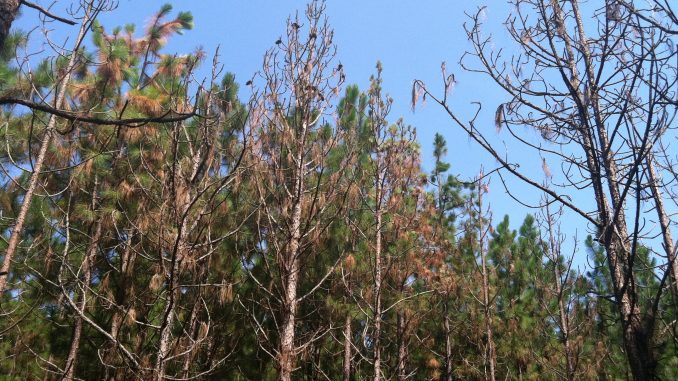
What the Southern pine beetle and other similar species lack in size they more than make up for in destructive power. According to the North Carolina Forestry Service, the Southern pine beetle alone caused nearly $60 million in damages between 1998 and 2002.Certain Southern states Alabama and Georgia in particular have seen a large resurgence of pine beetles due to factors such as wildfires and drought. While these effects have not been seen to the same extent in North Carolina, landowners should still be on guard against this alarming arthropod.Jeremy Callicutt, a North Carolina forest ranger in Stanly County, shared some of his insight about the pest. While the Southern pine beetle is certainly a threat to be aware of, Callicutt said the more common bug in the area is the ips bark beetle. According to Callicutt, it has been roughly 47 years since a large scale (100-plus acres) infestation of Southern pine beetles has been found in North Carolina, though many smaller scale outbreaks have been found.Signs of infestationSigns landowners may look for that indicate the presence of beetles include browning of the trees needles and the presence of pitch tubes, which are small nodes of sap from where the beetle has tried to enter or exit the tree.Callicutt noted that if the aforementioned signs of pine beetle presence are found it is important to distinguish which type of beetle is causing the damage in order to administer the proper treatment. If the ips beetle is present there will be line-shaped grooves underneath the tree’s bark left over from the beetles burrowing, while the Southern pine beetle leaves winding S-shaped grooves under the bark. These grooves are what ultimately kill the tree by preventing the flow of nutrients.Methods of treatmentDepending on which beetles are present the proper course of action will differ. If the ips beetle is found, simply removing the trees showing symptoms should be adequate to stop the bug. Southern pine beetles however require the removal of both symptomatic trees and nearby trees to stem the flow of the insect. Landowners can contact their local forest service for assistance in resolving the issue.Callicutt added that the most effective method of treatment for the beetles is prevention. Ensuring that populations of planted pines aren’t overcrowded can provide an excellent defense against the pest. Properly thinning tree populations makes for healthier plants that are more capable of repelling a pine beetle attack. Additionally, while certain species of pine such as the longleaf can be more resilient to the beetles, all breeds of pine are susceptible to some degree.While the danger of these beetles is certainly present, North Carolina has done a very good job of keeping the pest’s population under control. Forest service actions such as the controlled burn program serve to curb the spread of the beetle, while the aerial survey program helps identify clusters of brown needles where the pine beetles may be present. Though there may not be a clear-cut solution to the problem posed by the beetles, maintained vigilance at both the state and local levels can effectively put a halt on the spread of these nuisances.



